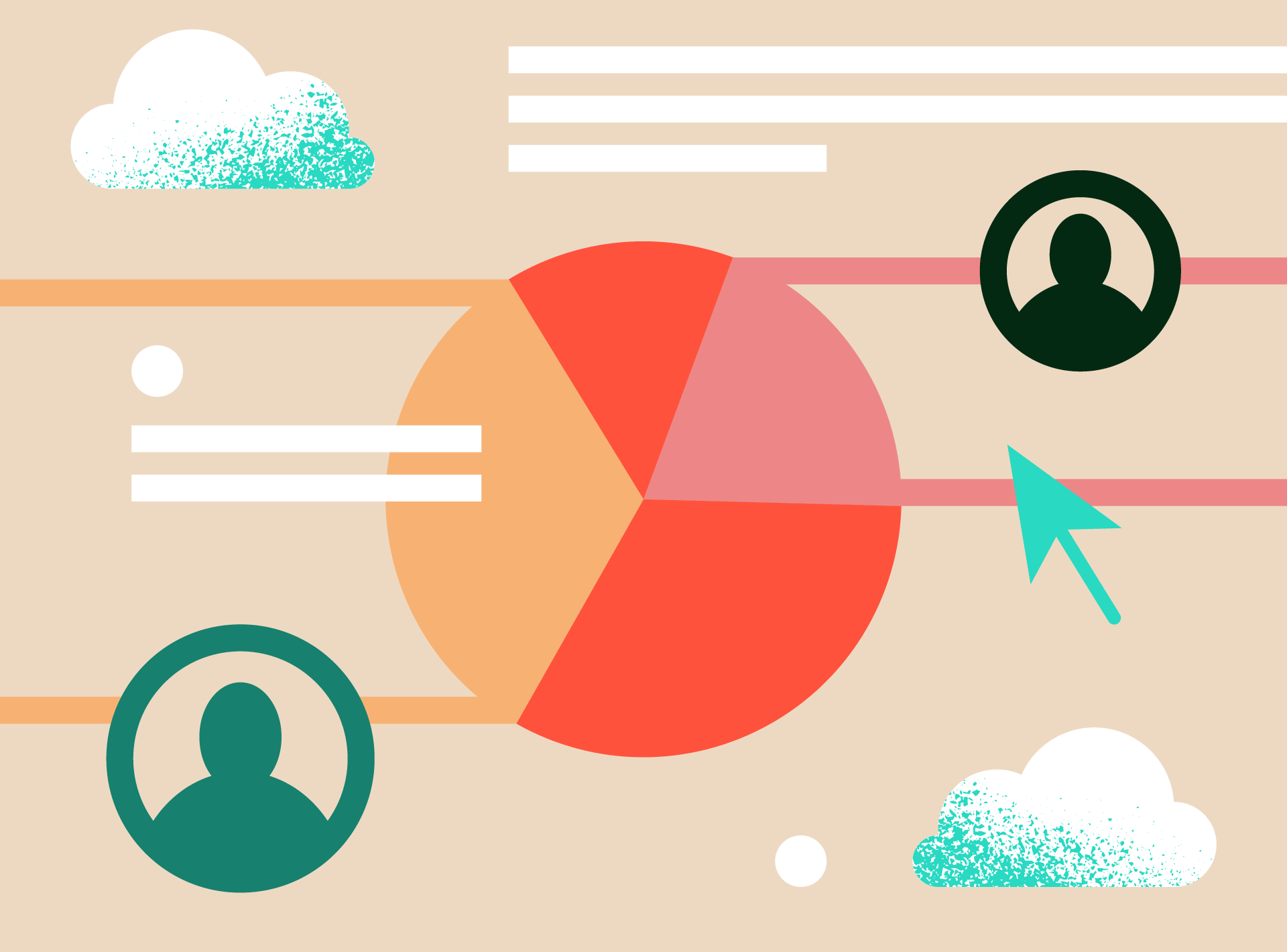There are at least six ways of getting to know your audience better. In this article we’re going to show them to you. They will help you understand your customers and their needs. As a result, you will be able to provide them with excellent customer service and tailored products and services. It sounds like a recipe for success, doesn’t it?
Running a successful business comes down to two things:
- Reaching the right target audience with the right message and at the right time
- Providing customers with products and services that are tailored to their needs and expectations
Of course, easier said than done! That’s why today, we want to show you six practical ways of understanding your customers. It’s a good starting point for the further development of your business.
Use Google Analytics
It all starts with your website and an analytics tool that tracks traffic flowing through your website to give you actionable insights on:
- What are the characteristics of people visiting your webpage
- Where they come from (from what sources and using what channels)
- What actions they take on your websites (e.g., what subpages they visit) and more
For the sake of this article, we’re going to concentrate on the “Audience” tab. Inside, you get access to a lot of valuable data, i.a.:
- Active users (how many users your website actually has)
- Demographics (age groups and genders)
- Session quality (in Google jargon, session is one visit on a website)
- Conversions (how many users do what you expect them to do)
- Location of your users (the “Geo” tab)
- And behaviours
The last section is particularly interesting. It looks like that:
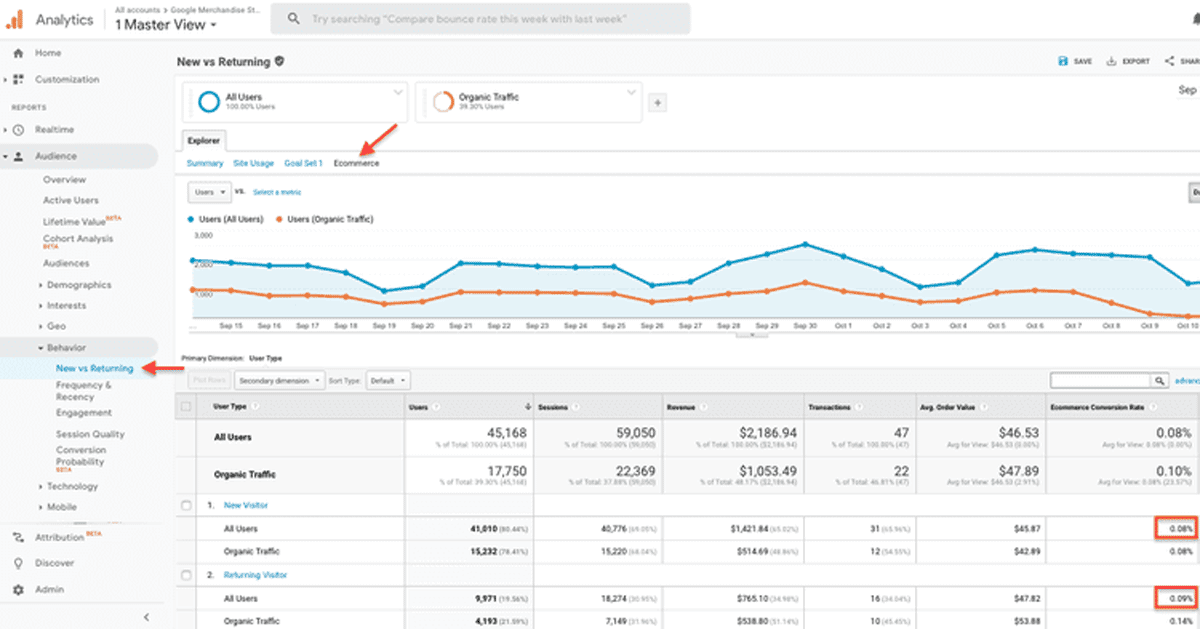
The behaviour tab lets you know how well your website engages viewers. It allows you to find out whether users are leaving your website only after opening the main page (so-called bounce rate), which means they are not interested in what they see. If they don’t and they spend some time on your page, what sections are particularly interesting? How much time do they spend on it? With this knowledge, you can see which elements on your website work well, and which require some tweaking.
Additionally, you should be vitally interested in the “Acquisition” section that shows you all the channels your users use to get to your website. These channels can be:
- The search engine
- Social media
- Other websites and online platforms
If you want to find out more about this great tool, use this guide provided by Google:
Know your audience by analyzing current customers
The more you know about your customers, the better. There are a few ways enabling you to gather vital information about your customers. Let’s have a look at them:
SURVEYS
First off, you can use customer surveys and questionnaires. They are extremely useful when you want to know the answers to specific questions. In the last chapter of this article, we will show you two useful tools to conduct such surveys. How can you encourage customers to take part in your surveys? You can use available communication channels, such as:
- Social media profiles
- Newsletters
- Push notifications
To ask them to participate in your survey. You can also offer a small incentive, e.g., a free delivery or a discount for the next purchase. What’s crucial is that you don’t make customer surveys too complicated and time-consuming. Ideally, a survey should be done within less than two minutes.
CUSTOMER ACCOUNTS
Secondly, you can create customer accounts with the possibility to fill in additional information, e.g., concerning their interests. That’s what many SaaS platforms and e-commerce companies do, especially at the beginning when there is no additional data about a given person.
THE ONBOARDING PROCESS
If your company/service requires the onboarding of each new user, that’s an excellent opportunity to find out more about your customers. During the onboarding process, you can ask for additional information and allow new users to choose different options that fit their needs. Their answers will tell you a lot about their requirements and preferences.
WHAT KIND OF DATA TO COLLECT
That, obviously, depends on the profile of your business. If you run an online store, you should be vitally interested in basic characteristics (gender, age), previous purchasing history and previous searches in your store’s search engine. If you run a B2B company, concentrate on previous orders and queries. You can also create a user persona to find out more – we’ll talk about that in a minute.
Your website/store should be integrated with an analytics tool that will enable you to get useful insights from all that information. Analysing customer data manually can take a lot of time, so you should automate that. To some extent, Google Analytics is a great source of customer data, but we want to show you one more tool: Hotjar.
HOTJAR
Hotjar is a comprehensive platform for product teams and website owners who want to go beyond traditional analytics and find out more and understand their users in order to improve UX and their offerings. With Hotjar, you can:
- Get live customer feedback on your website
- Conduct customer surveys
- Use heatmaps to see where users click, move and scroll on your site
- Map customer journeys from entry to exit to see what actions your customers take on your webpage
AI ANALYTICS
Lastly, you can opt for AI-powered analytics to understand your customers even better. There are platforms like AnswerRocket that use AI and machine learning to analyse your customer data and provide you with useful insights on what it actually means and how it influences your business.
Create buyer personas
Buyer personas help you understand who you’re talking to and what kind of people you are trying to reach. With them, you can build awareness of your customers’ buying insights. It’s also a representation of your ideal or typical customer/client.
If you want to get in-depth knowledge on how to create buyer personas, take a look at the book published by Adele Revella, CEO of Buyer Persona Institute.
There are two ways to create a buyer persona. You can either concentrate on people you WANT to reach and create a buyer persona that reflects your aspirations or focus on people you ACTUALLY get – your current customers.
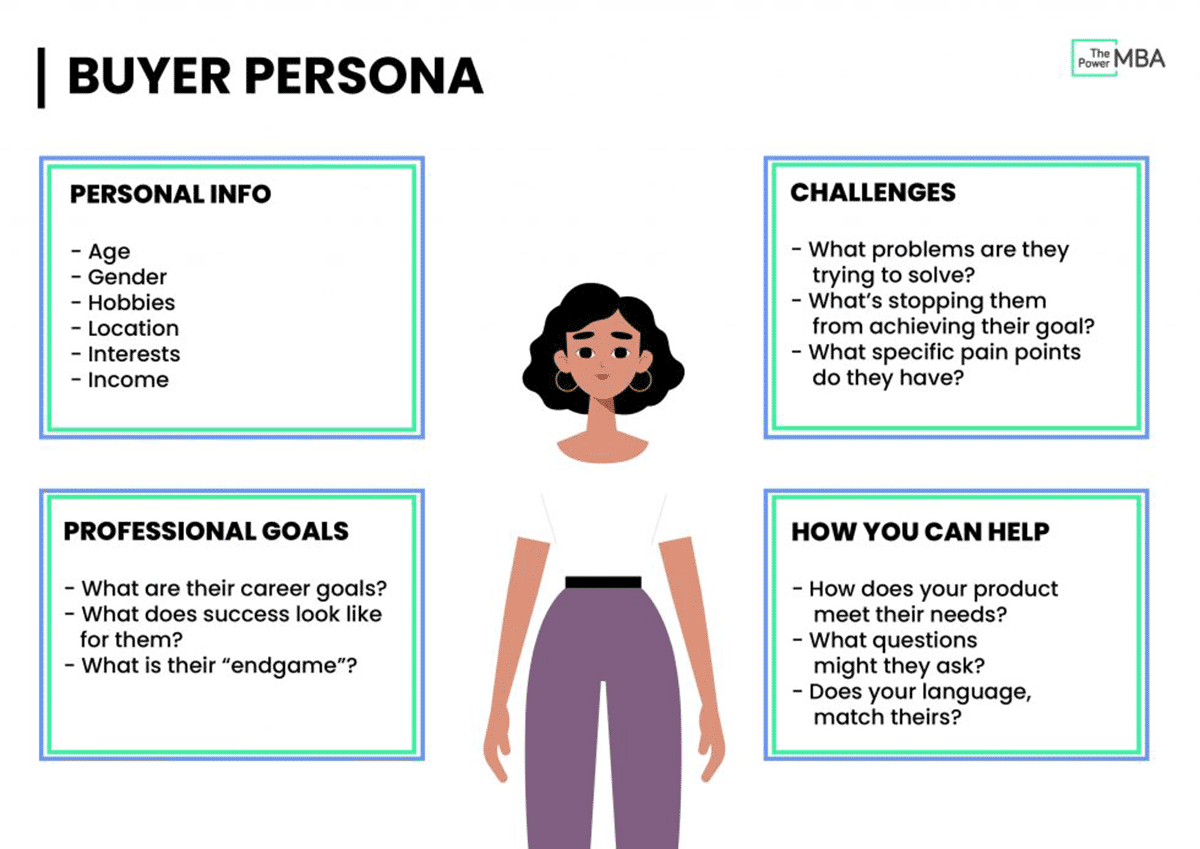
A buyer persona is a fictional character that represents your target audience’s main characteristics and qualities. It has the same interests, fears, challenges and motivations. Some companies even give their personas names, professions and addresses. You don’t have to go that far. Here are the elements to concentrate on:
- Main characteristics/personal information (so that you know WHO to target)
- Typical needs and problems (and how you can help with them)
- Major challenges they have to face daily (and how you solve them)
- Goals, aspirations and motivations
Keep in mind, though, that especially in the B2B world, demographic data is less important than your clients’ motivations, pain points and challenges. Revella calls that “The 5 Rings of Insight” – they tell you what triggers the buyer’s interest. Here are these Rings:
- Priority initiatives (What causes buyers to invest in a solution like yours?)
- Success factors (What results do your customers expect from purchasing your solution?)
- Perceived barriers (What concerns your buyers might have?)
- The buyer’s journey (What are the stages leading to buying a product or ordering a service?)
- Decision criteria (Which aspects of your offer your customers perceive as crucial ones?)
Concentrate on them when working on a buyer persona.
HOW TO CREATE A BUYER PERSONA
In the previous heading, we showed you how to analyse data about your customers. It’s a perfect base for your future buyer persona. Gather all that you know about your customers and use this knowledge.
First, you can talk to people who have direct contact with customers (e.g., your sales team), as well as other teams working with customers (e.g., customer service). Ask them how they understand their customers’ buying insights. The next step is to talk directly to customers (both those who were satisfied and those who were disappointed and who withdrew from cooperation).
Here, qualitative research is crucial. Conduct in-depth interviews with customers in order to deeply understand their motivations and the decision-making process. If you need help with that, Admind has an internal research team that can conduct such interviews for you.
WHY DO YOU NEED A BUYER PERSONA?
- With it, you can improve your company’s offer (82% of companies using personas said they improved their value proposition)
- You reach new customers more effectively (71% of companies that exceed lead generation and revenue goals have documented buyer personas)
- You create better UX for your customers/users, which also contributes to higher sales and more stable business (using buyer personas in the web design process helps improve usability up to five times)
WHAT DO YOU DO WITH A BUYER PERSONA?
Shortly put, you use this knowledge to adjust your product as well as sales and marketing efforts. Suppose that during your research, you find out that most of your customers are active on Facebook, and some of them know your brand from that social media platform. It indicates that you should increase your activity on this platform and opt for Facebook Ads to reach more people.
Know your audience through competition monitoring
Your competitors likely try to get to the same or similar target audience. Therefore, monitoring competitors and their activities can give you more insight into your target audience. Plus, you can come up with new ideas on how and where to reach potential customers.
HOW TO MONITOR COMPETITORS
First off, you should create a shortlist of two or three companies that have the closest business profile to yours. Analysing twenty different companies would be very time-consuming and inefficient. It’s better to concentrate on three direct competitors. Analyse their websites and offers to see which companies tick most of your boxes.
Of course, you can use many tools to monitor different aspects of your competitors’ offers and traffic, but today, we want to show you three that are particularly useful: Similarweb.com, Ahrefs and Brand24. With them, you can get a more in-depth insight into your competitors’ target audiences, keywords that they use, the most effective sales and marketing channels and even marketing tools in their stack.
SIMILARWEB
Let’s start with the first tool and run such an analysis for the Salesforce.com website. You don’t even have to open an account to get basic information. All you need is a specific URL address you want to monitor. Here’s what you get in the “Audience” section:

The first things you see are basic traffic and engagement statistics from the last month. We want to turn your attention to the last section, though. It provides more information on the given target audience’s interests. This part is especially vital:
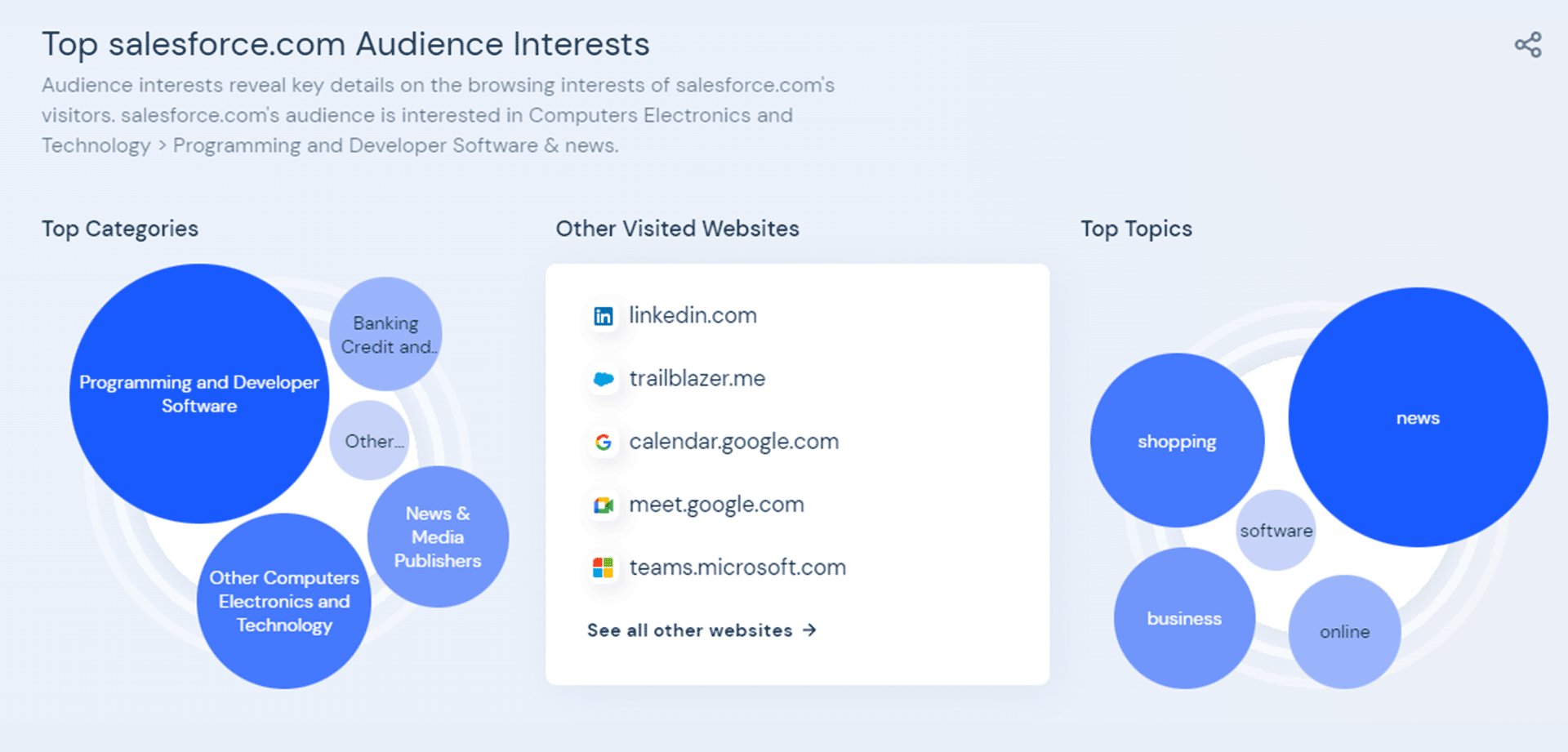
Here, you can discover the essential categories and topics that Salesforce’s users are usually interested in. There is also a list of other websites visited by the same people. Thanks to this knowledge, you know what to talk about to trigger interest and where to promote your products and services (e.g., with ads and guest posts).
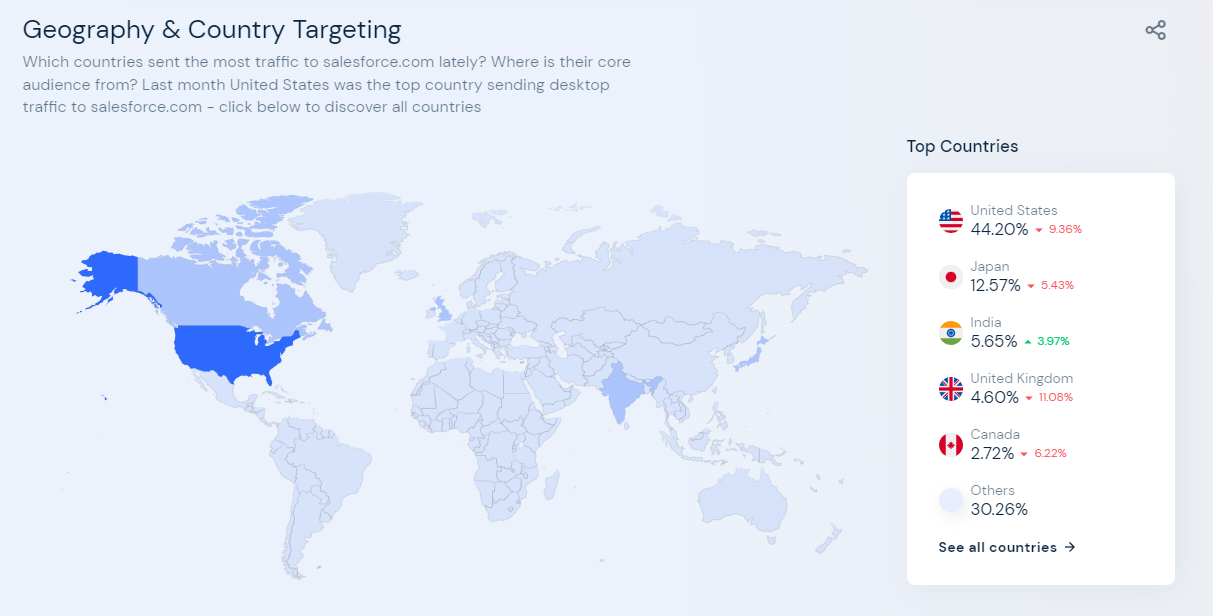
AHREFS
That’s one of the most comprehensive SEO tools in the market. With it, you can discover what keywords and key phrases your competitors use. This way, you can see how to reach potential customers more effectively by using the right statements and messages. Additionally, such information can be very useful in creating and executing a content marketing strategy for your company. It’s a good starting point to come up with new blog posts and subpages on your website to trigger more interest among potential customers.
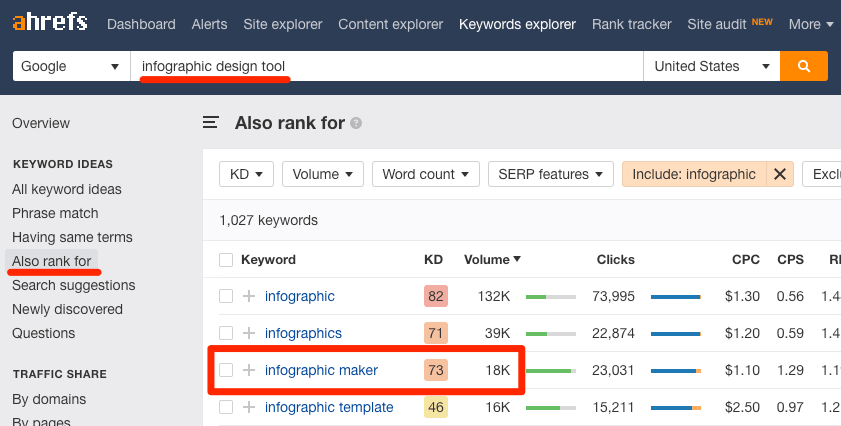
BRAND24
It’s one of the best social listening tools (we will discuss them further in the next chapter). Brand24 enables you to monitor all the mentions about your brand online. It also allows you to monitor mentions about your competitors. With such input, you can analyse in what context your brand (and competitive brands) is mentioned online. It’s also a good way to discover what your current and potential customers are interested in and what are their problems and challenges.
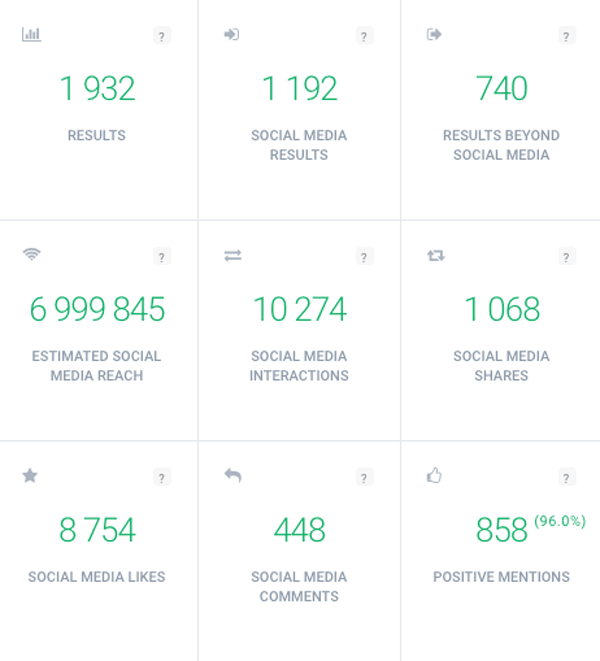
Social listening
People are talking about brands online almost non-stop. Social media, internet forums and comment sections under articles and blog posts are full of mentions about different brands and companies. It is likely that people are talking about your company, too! Why should you know what they are talking about your brand? Primarily because that’s the most authentic feedback you can ever get.
Social listening lets you discover what people think about your company and your products or services. If they are flustered because someone at one of your stores treated them badly, you’ll know about that. You’ll also know if they can’t find the right product in your company.
Social listening is a powerful tool that gathers all the mentions about your brand simultaneously from many different places. And the bigger your company, the more mentions there are. In fact, it’s impossible to gather (let alone analyse) all the comments online – there are thousands of them, and every day more are coming.
With a social listening tool, you can understand your target audience better. You can see:
- In what contexts is your brand mentioned
- What people really think about your products and services
- If they are satisfied with your customer service
- What they want to change about your company
And much more priceless information. That makes social listening a perfect audience analysis tool. Not only do you see what people are saying, but also where (on what websites, blogs, social media profiles, etc.), which is crucial from the marketing point of view.
SOCIAL LISTENING TOOLS (AND A CASE STUDY)
In the previous heading, we mentioned Brand24 as a worthy social listening tool. Of course, there are others that you can use. Take a look at these SL platforms:
- BuzzSumo
- BrandWatch
- Talkwalker
- Mention.com
Even Google offers a similar service (and it’s free). However, Google Alerts is not a perfect SL tool; it won’t inform you about all the mentions about your brand, as it concentrates exclusively on the mentions that can be found in this search engine.
To show you how social listening can be useful in your company, let’s analyse the TimeCamp case study. TimeCamp is a time-tracking and task-management app used by teams and freelancers. They use a social listening tool not just to gather and analyse mentions about their brand but also to spot interesting threads that they can comment on as a platform.
Such a technique can be extremely effective. One time, a single Twitter post generated 30 visits to the TimeCamp website, and all of them were made by their target audience. These three visits resulted in 3 registrations, a 900% increase over the normal user activity at TimeCamp!
So yes, social listening can help you not just understand your target audience and its needs but even generate sales!
Different forms of content and A/B testing
Lastly, you need to find out what resonates with your target audience. To check that, you need to try different forms of content and use an analytics tool (e.g., Google Analytics) to verify what creates the most engagement.
Today, the list of available content forms is actually quite extensive. After all, you can opt for the following:
- Blog posts and guest posts
- Social media posts
- YouTube videos
- TikTok videos
- Podcasts
- Webinars
- Ebooks, whitepapers and reports
- Newsletters
- And, of course, ads promoting them
Try different forms of content and use ads to promote them among current and potential customers. Only if you gather a sufficient audience can you verify whether a given form “clicks” with your customers. If you want to start using a new form of content, you can create a separate landing page just for it (and, e.g., encourage people to sign up for it or download it). Such an activity works best with online events and so-called lead magnets.
A/B TESTING
It is also valid to test each idea separately. For example, if you want to conduct a webinar, you can create an A/B testing campaign to see what your users expect. In the A version, your webinar could last 20 minutes, and in the B version – 40 minutes. Create two landing pages promoting a shorter or a longer webinar and see which version gets the most clicks and sign-ups.
You can conduct A/B tests on your own or with testing software, such as Google Optimize, Adobe Target or Oracle Maxymiser. Just remember two important rules when it comes to A/B tests:
- Test one thing at a time. This way, you can find out what works better and why. If you test two completely different products, you won’t be able to pinpoint what caused the difference.
- Measure, measure, measure. A/B tests make sense only when they are thoroughly measured. Ensure that everything you want to test is integrated with your analytics software.
ASK FOR THE FEEDBACK
If you want to go beyond typical A/B tests, you can also ask your users/customers for feedback. It’s also a vital source of information about your target audience. You can use at least two different customer surveys to discover what people think about your company:
- Net promoter score (NPS): It’s an easy-to-use tool that has just one or two questions:
- “How likely are you to recommend us to your friends and family?”
- “Why did you answer that way?”
- Customer satisfaction score (CSAT): Here, the customer is asked whether they are satisfied with the service, and they have just three answers: Satisfied, neutral, or dissatisfied.
Of course, you can also simply ask about their opinion via social media or newsletters. Every feedback you get from your customers is essential, no matter the form.
Summary
We hope that this article helped you understand how to reach your target audience. Now is the time to design a company that provides these customers with what they need. And this is where our role begins. At Admind, we will help you conduct the necessary research and then design a brand that ticks all of your customers’ boxes. Contact us to find out more today!

